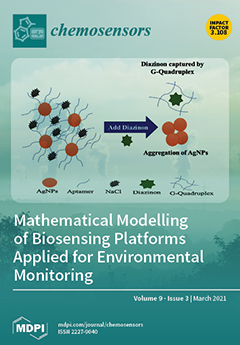Surface imprinting used for template recognition in nanocavities can be controlled and improved by surface morphological changes. Generally, the lithographic technique is used for surface patterning concerning sensing signal amplification in molecularly imprinted polymer (MIP) thin films. In this paper, we describe the
[...] Read more.
Surface imprinting used for template recognition in nanocavities can be controlled and improved by surface morphological changes. Generally, the lithographic technique is used for surface patterning concerning sensing signal amplification in molecularly imprinted polymer (MIP) thin films. In this paper, we describe the effects of silanized silica molds on sensing the properties of MIP films. Porous imprinted poly(MAA–co–EGDMA) films were lithographically fabricated using silanized or non-treated normal silica replica molds to detect 2,4-dichlorophenoxyacetic acid (2,4-D) herbicide as the standard template. The silanized mold MIP film (
st-MIP) (Δ
f = −1021 Hz) exhibited a better sensing response than the non-treated normal MIP (
n-MIP) (Δ
f = −978 Hz) because the imprinting effects, which occurred via functional groups on the silica surface, could be reduced through silane modification. Particularly, two non-imprinted (NIP) films (
st-NIP and
n-NIP) exhibited significantly different sensing responses. The
st-NIP (Δ
fst-NIP = −332 Hz) films exhibited lower Δ
f values than the
n-NIP film (Δ
fn-NIP = −610 Hz) owing to the remarkably reduced functionality against nonspecific adsorption. This phenomenon led to different imprinting factor (IF) values for the two MIP films (IF
st-MIP = 3.38 and IF
n-MIP = 1.86), which was calculated from the adsorbed 2,4-D mass per poly(MAA–co–EGDMA) unit weight (i.e., Q
MIP/Q
NIP). Moreover, it was found that the
st-MIP film had better selectivity than the
n-MIP film based on the sensing response of analogous herbicide solutions. As a result, it was revealed that the patterned molds’ chemical surface modification, which controls the surface functionality of imprinted films during photopolymerization, plays a role in fabricating enhanced sensing properties in patterned MIP films.
Full article





